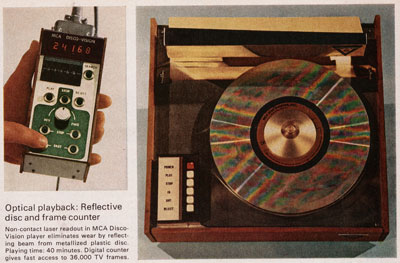
 |
Search | FAQ | US Titles | UK Titles | Memories | VaporWare | Digest | |||||||
| GuestBook | Classified | Chat | Products | Featured | Technical | Museum | ||||||||
| Downloads | Production | Fanfares | Music | Misc | Related | Contact | ||||||||
| CED in the History of Media Technology | ||||||||||||||

The public got their first exposure to the MCA Disco-Vision system on December 12th, 1972. This was the first system to use a laser and reflective optical techniques to play back VideoDiscs. The disc surface consists of a spiral track containing micropits that modulate the beam of the laser as it passes over, permitting reconstruction of the encoded video signal. The initial Disco-Vision discs were mylar and very thin, about the same thickness as the Teldec system discs. The 1972 Demonstration consisted of 7 minutes of material from 22 movies, and was touted as the first showing by any disc system of more than 5 minutes of material, even though RCA in September 1972 had produced CED Disc #234 containing 10 minutes of programming.
The 1972 Disco-Vision system spun the disc at 1800 RPM, which permitted 20 minutes of playback on CAV (constant angular velocity) discs, where each spiral track on the disc contained one video frame. This permitted dial-in access to any of the 36,000 individual frames using the wired remote control shown on the left above. CLV (constant linear velocity) discs permitted 40 minutes of playback on one side, but didn't permit access to individual frames. Philips had a very similar system to Disco-Vision under development in Europe, and the two companies decided to merge their efforts after the 1972 demonstration. When the DiscoVision system (without hyphen) reached the market in late 1978, the discs were rigid and two-sided, with 54,000 frames per side (permitting 30 or 60 minutes of programming per side).